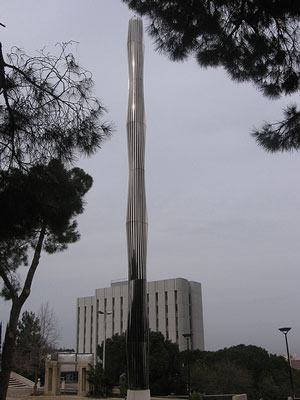| Posted: June 1, 2009 |
Calatrava dedicates sculpture to recognize contributions to Russell Berrie Nanotechnology Institute |
|
(Nanowerk News) Dr. Santiago Calatrava – the world-class architect known for large-scale, innovative designs – will officially unveil his latest creation, “The Obelisk,” on June 2, 2009 at the Technion-Israel Institute of Technology in Haifa, Israel.
|
|
The towering, kinetic structure – visible from almost every direction on the Technion campus – is being dedicated to the memory of entrepreneur and philanthropist Russell Berrie, and will help recognize the unprecedented contributions made by the Russell Berrie Foundation to establish the university’s Russell Berrie Nanotechnology Institute (RBNI).
|
 |
| Calatrava sculpture "The Obelisk"
|
|
Located in a park-like setting at the very heart of the Technion campus, the Obelisk will serve as a physical symbol of the RBNI, one of the world’s leading centers dedicated to advances in nanotechnology, the tiniest of sciences. The structure’s representation of the RBNI is especially significant because the institute’s multi-disciplinary nature makes a virtual center more practical and efficient than a central building.
|
|
“The Obelisk is a celebration of science,” says Calatrava. “It celebrates the very technical and very mechanical as things of beauty, and is meant to mirror daily life at the Technion, one of the world’s most celebrated technical universities.”
|
|
The Obelisk is comprised of a subterranean reinforced-concrete foundation, topped by a stone, a nearly 10 foot-high cone-shaped pedestal and crowned with an 82-foot glinting tower. The structure is surrounded by a 34.5 feet in diameter circular pavement made from local off-white dolomite. The tower houses an external skin of 224 moving stainless-steel ribs, arranged in eight levels. These elements are designed to permit a wave-like motion generated by the electric motor that sits atop the mast; each moving rib induces the sequential motion of the next, from the top level to the bottom.
|
|
“The effect of this sinusoidal movement,” explains Project Manager Dr. Michael Polonsky, “is an illusion of the whole monument rotating on its axis; actually, the movement is more akin to our ribcage moving in and out during the process of breathing.”
|
|
|
|
The entire structure, lit by 10 illumination points set in the pavement, stands more than 91 feet high, more than 650 feet above sea-level. Dr. Calatrava, who received an Honorary Doctorate of Science from the Technion in 2004, also holds the appointment of Technion Distinguished Visiting Professor.
|
|
The Technion-Israel Institute of Technology is Israel's leading science and technology university. Home to the country’s winners of the Nobel Prize in science, it commands a worldwide reputation for its pioneering work in nanotechnology, computer science, biotechnology, water-resource management, materials engineering, aerospace and medicine. The majority of the founders and managers of Israel's high-tech companies are alumni. Based in New York City, the American Technion Society (ATS) is the leading American organization supporting higher education in Israel, with offices around the country.
|

